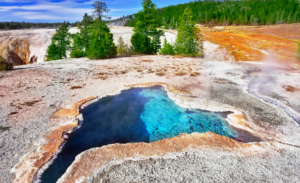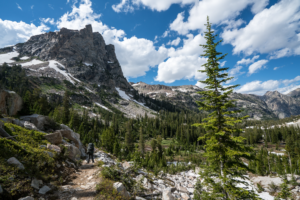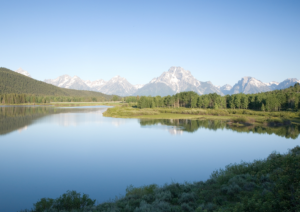
Grand Teton National Park is one of the places I find so amazing in Wyoming! With rising mountains, clean lakes, and many excellent hiking trails, there are lots to do in Grand Teton National Park throughout the region.
Grand Teton National Park offers some of the best day trips and multi-day backpacks in our country and is meticulously tucked into 310,000 acres of gross beauty. The majestic scenes are accompanied by a rich history and an incredibly diverse fauna. There are trails for all skill levels, which makes this park indeed a park for people. Here are some of our favorite trails at Grand Teton National Park, a park that always holds a special place in the hearts of those who love the outdoors.
No boarding pass is required in Grand Teton National Park. However, you will need to obtain permission to stay in the countryside or at the Jenny Lake Ranger temporary station. Learn about mountaineering at Grand Teton.
One of the most popular activities is hiking in Grand Teton National Park. There is a wide range of hiking trips, from short and flat climbing to more prolonged and steeper climbing. All have water features from streams gushing into the valley and high alpine lakes. In general, wild animals such as deer, deer, black bear, and smaller mammals can be seen.
Proper planning is required, from checking the weather to adequate hydration, clothing, and conditioning of the spray for bears. Rewarding experiences await those ready to leave the paved surface and enter the remote Teton region.
Hiking in Grand Teton National Park can be a challenge, and hiking above your fitness level can make the day less fun on the trail. Here is a list of hiking trails here, based on hardness and most accessible to hardest.
This list of 10 will help hikers find a trail that best suits their abilities:
1. Cascade Canyon Trail and Lake Solitude

From Jenny Lake Trailhead, you can reach Cascade Canyon, either walking a few miles around Lake Jenny or hopping on the Jenny Lake Ferry, which takes you on water walks every 15 minutes. Using the ferry saves time and energy, both of which are necessary to reach the rugged and beautiful Cascade Canyon.
A trip through Cascade Canyon is happily rewarded by the gleaming shores of Lake Solitude, seven miles from where the ferry departs. As you travel through Cascade Canyon, each step increases your exposure to steep mountain views.
At the entrance to the northern fork of the Cascade Canyon, hikers are advised to look behind to see the iconic Grand Teton view perched on the canyon walls. Water and snacks are recommended for this intense hike of over 2,300 feet.
After traveling 7 miles to Lake Solitude, hikers may be shocked to see the crowded conditions around the water. However, there is plenty of room to participate in the iconic Teton Landmark. If you start hiking early, you will have free time to explore the coast and admire the postcards with mountain views. If the weather is warm enough, take a quick swim in Solitude Lake to enjoy an incredible wave of excitement.
2. Coulter Bay
Colter Bay Village offers a variety of activities, including excellent hiking. You can combine a kayak trip or boat rental at the marina, join a chat or ranger tours, go horseback riding or take a cruise. Allow a full day to make the most of it.
Close to Colter Bay Village and the Visitor Center, the Hermitage Point Trail passes through an aqueous environment that eventually leads to the shores of Lake Jackson. There are plenty of small side trips and views along this ten-mile route, including Lake Swan and Heron Pond. In addition to the lives of exposed birds, there are also observations of moose, beavers, and bears.
3. Marion Lake
How often do you have the opportunity to start a hike from the top of a mountain? The hike to Lake Marion begins at the top of the mountain. Rendezvous – after a 12-minute tram ride to the top. The trail offers excellent views along Upper Granite Canyon before reaching Little Marion Lake just below Mount Housetop.
Following the tributaries and streams of the mountains that flow into the nearby Snake River, the Granite Canyon steadily climbs through landscapes filled with giant boulders, dense forests, and expansive mountain landscapes. A day trip to Granite Canyon is an experience for hiking and walking. Lake Marion, nine miles from the boardwalk, is a beautiful sight.
It is an excellent height of over 3000 meters to reach Lake Marion. For hikers who want a bit of the edge to get to Lake Marion, the nearby Jackson Hole Mountain Resort offers a tram ride to Rendezvous Peak, reducing the mileage and altitude in the equation. Anyway, it’s an exercise, but with very few crowds Marion Lake shares, the bonus is a beautiful lake under the Alps.
4. Jenny Lake

Lake Jenny is probably one of the most famous landmarks in Grand Teton National Park, and rightly so amazing.
You can enjoy lots of local activities here, including kayaking (I used this equipment), as well as some excellent hiking trails around the lake and mountains.
For an easier route, take the shorter round trip to the Hidden Falls. Take the Jenny Lake Trail and take a short walk along the Cascade Trail to take in the scenery without hiking all day! It’s easily the most popular sport in the park and one of the best must-see spots in Teton National Park.
Visit Jenny Lake Overlook for breathtaking views. This was my first stop in the park, and its beauty is everything (it looks like cheese but is accurate).
5.Mormon Row

If you’re a fan of history, you’re going to love Morum Row! Established as a Mormon plantation settlement in the 1890s, it is one of the best places in Grand Teton National Park for a bit of history.
Built over the decades, it is a perfect setting for images that cannot be missed. It shows the size of the Teton Mountains and is very impressive.
Plus, it’s not far from the Jackson Hole ski area – which means you can see them both on the same day.
6. Phelps Lake Trail
Southwest of the Moose of Grand Teton National Park entrance, Lake Phelps is a unique feature of the Death Canyon Trail. From White Grass Ranger Station, the Phelps Lake Trail first ascends to view the water before diving again to reach the glacier-fed lake. The Phillips Lake Trail leads to the beach and is steep enough to be considered uphill. This helps ensure that this natural attraction is less crowded than others in the area.
It takes just over four miles of sidewalk to orbit Lake Phelps and get back on track completely. Alternate routes, including the routing system leading to the Laurance S. Rockefeller Reservation, make the Phelps Lake Trail easy to upgrade to a full-day adventure.
You can also hike the Laurance S. Rockefeller Reserve, but arrive early as the parking lot here fills up quickly in the summer months.
7. Taggart Lake
For a shorter excursion with instant views of Grand Teton, Lake Taggart is a 3-mile round trip that reveals massive rocks along the way.
Starting from the Taggart Lake Trailhead, near the southern entrance to Elan Park, the trail gradually climbs through a wooded area and eventually reaches the calm waters of Taggart Lake. The route gains minimal altitude along the entire way and is beautiful broadband.
For hikers looking for more adventure, the trail continues another mile to the shores of Lake Bradley. Continuing to Lake Bradley is the best way to eliminate some of the crowds in the area. Regardless of the distance covered, the Taggart Lake Route only climbs to an average height, making it an easily accessible place that almost every family member can enjoy.
8. Teton Village and Craig Thomas Center
Craig Thomas Discovery is near the Snake River and offers countless views of the Grand Teton National Park, which is worth seeing. It’s perfect if you want to overview the area’s history and use the ranger expertise here – I know everything!
A stop at the visitor center will allow you to explore part of this area of the park. It’s an excellent anchorage for exploring Lake Phelps (via the relatively easy loop road).
Additionally, you have the Jackson Hole Ski Area, which also serves as the base for Teton Village. It’s a great place to ski and snowboard, and the ski passes are perfect for beginners.
9. Death Canyon Trail
Far from its negative implications, Death Canyon is a welcome area in Grand Teton National Park. It offers intimate views of the rugged ocean and great views of wildlife and seasonal wildflowers along the way.
The only thing worthy of mourning in Death Canyon is once your feet shine. Death Valley is undeniably steep, rising more than 2,000 feet in the four miles required to reach the Static Peak Divide.
The trail begins at the White Grass Ranger Station and meets the mile downstream to enjoy Lake Phillips. From here, altitude changes continue, and road users have a few destinations to choose from when exploring the Death Canyon. A steady peak intersection, four miles down the trail, is often a good turning point. For those with an early start and strong legs, the crossover leads to either the Static Peak Divide or the Death Canyon Rack.
10. Alaska Basin
The Alaska Basin, which can be reached west of Grand Teton National Park via Dregs, Idaho, may contain some of the most significant alpine habitats the Teton Range offers. However, this stunning mountain landscape is not easy to get to, and those who want to experience the Alaska Basin will have to put some energy into doing so.
On the Alpine Trail, eight miles from the Teton Canyon campsite, hikes in the Alaskan Basin are known to be partly muddy, some are rocky, and include a notorious section known as Devil of the Stairs.

Hikers reach more than 2,600 feet to reach the Alaska Basin, and potential hazards cover the entire path. Some of the risks include bad weather, speed of movement, bears and other wildlife, and the severe chance of never wanting to leave once you’re gone. The end of July and August are good times for hiking when the trail is mainly free of snow.
Where to stay near Grand Teton National Park for sightseeing
Grand Teton National Park and the Adventure City of Jackson are many great places to spend the night.
The accommodations are scattered throughout the city and around Jackson Hole Valley and range from decadent settings to dollar savings.
Luxury Hotels:
For the most beautiful stay near Grand Teton, the Four Seasons Resort and Jackson Hole Residences in this Teton Village just near Jackson Hole Mountain Resort offer babysitting services, spacious rooms, and incredible mountain views from every window.
Not far from Rusty Parrot is the Word Hotel, another prestigious luxury hotel in the heart of downtown Jackson, in a historic building. It strives to pay strict attention to details when it comes to comfort, style, and class.
‘Mid-Range Hotels: For the most facilities at the best prices, we recommend checking out the Cowboy Village Resort on the west end of town, which has spacious rooms and well-kept facilities, and a rustic feel that adds an extra layer of comfort.
Farther west, the Wyoming Inn of Jackson Hole features large windows with every Grand Western room and lounge to enhance comfort throughout your stay.
Near the north end of town, the Rustic Inn Creekside Resort and Spa in Jackson Hole is competitively priced, spa services, lavishly appointed rooms, and quick access to the national park.
Discount Hotels: To save you vacation money on your daily attractions, some cheap accommodations don’t sacrifice a quality stay.
Super eight Driggs in the Idaho is affordable, with decent rooms and immediate access to the western slopes of the Grand Teton National Park.
In Jackson, both the Parkway Inn and Ranch Inn offer affordable room rates and complimentary breakfast, plus spacious rooms and comfortable beds for a good night’s sleep.
Grand Teton National Park is a very high park. Elevation increases the likelihood of dehydration, severe sunburn, altitude sickness (headache, nausea, dizziness), and worsening of pre-existing illnesses. Drink several liters of water every day to avoid dehydration.




